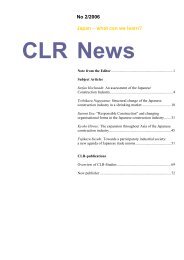Country report France - Construction Labour Research
Country report France - Construction Labour Research
Country report France - Construction Labour Research
You also want an ePaper? Increase the reach of your titles
YUMPU automatically turns print PDFs into web optimized ePapers that Google loves.
European Institute for <strong>Construction</strong> <strong>Labour</strong> <strong>Research</strong> – <strong>Country</strong> Report <strong>France</strong>CLR1. National Regulatory System Relevant for the <strong>Construction</strong> Industry1.1. Statutory and Collective Regulation of <strong>Labour</strong> RelationsFrench labour law is drawn up on four levels, whereby the requirements of the <strong>Labour</strong> Codeare attributed the greatest importance. In addition, in some areas there are interprofessionalcollective agreements, which assume a statutory nature. Examples of this are the conventionsfor professional training. At a third level there are the sectoral agreements to be concluded bythe trade unions and employers’ federations. Among other things it is prescribed by law thatthe sectoral negotiations are to be carried on at regular intervals. Wage bargaining forexample is to be conducted annually. Also at company level collective agreements may beconcluded. Here the labour code also prescribes intervals between negotiations (among otherthings regarding wages), provided there are trade union delegates in the company. The orderof precedence for regulations in the labour code provided that sectoral collective agreementshave to be more favourable than the statutory regulations, and the plant agreement morefavourable than the sectoral collective agreement. The great influence of the State on thecollective regulation of labour relations, particularly if compared to the voluntaristic Anglo-Saxon tradition of free collective bargaining, is apparent in its role as initiator and moderatorin collective bargaining as well as in the frequent application of the generally bindingdeclaration of collective agreements.The role of the <strong>Labour</strong> Code is further strengthened by the low level of trade union andemployers’ organisation. This is below 10% industry-wide on the trade union side (Courtoisand Labbé 2001) as well as about 5% in the construction industry (Druker and Dupré 1998).In construction, to a large extent characterised by SME’s, trade union membership ispredominantly concentrated in large and medium companies. The ideological trade union splitin a number of interprofessional umbrella organisations is also worth noticing. Trade unionswith the strongest membership in construction are members of the CFDT (Confédérationfrançaise démocratique du travail) and CGT (Confédération générale du travail). Socialdialogue is restricted to wage negotiations and the joint management of social funds.The structure of the construction collective agreement system is characterized by a divisioninto public works on the one hand (contractors that carry out infrastructure and other publicworks, for instance railway tracks and highway construction, tunnels and drains) and privateconstruction on the other. For both sectors independent wage negotiations are conductedannually with three employers’ associations, which are independent of each other (FNTP,FFB and Capeb). This does not exclude that agreements of the contractual partners showfundamental similarities since the industry federations on the trade union side haveconsciously not accepted any analogous organisational split.In private construction and public works, there are three national collective agreements (bluecollarworkers; administrative/technical employees; managerial and staff workers). For bluecollarworkers and administrative/technical employees wages are negotiated regionally (andthen declared generally binding). For the managerial and staff workers wages are negotiatedat national level. For workers in private construction there are two - generally binding -national collective agreements, one for employees in enterprises with less, and another forenterprises with more than 10 employeesWages are negotiated at the level of the 22 regions by the decentralized structures of theemployer’s federations and trade unions. In all, every year 88 wage negotiations take place for2









